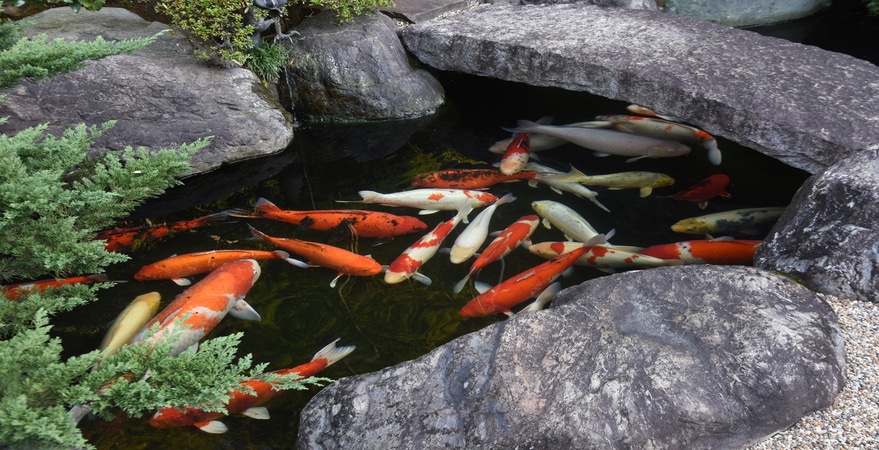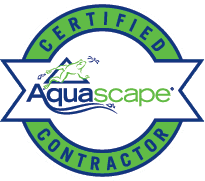Winter Koi Care in Colorado: Keeping Your Pond and Fish Healthy Through the Cold
Your koi may be beautiful, but they’re also dramatic. Even when the air is frosty and you’re bundled up, they’ll still swim toward you like they’re starving, following every step, hoping for one more snack. But no matter how convincing those puppy eyes are, winter koi care isn’t about how eager they look. It’s about what’s happening beneath the surface, inside your pond.
When Denver’s temperatures start dipping in late fall, your koi’s metabolism slows down. Their needs and your maintenance routine change completely. Feeding, cleaning, and equipment care all take on a seasonal rhythm. Here’s what you should know to keep your pond in top shape (and your koi healthy) all winter long.

1. Follow the Water Temperature, Not the Calendar
Koi are cold-blooded, which means their metabolism matches the temperature of the water around them. As it cools, they naturally slow down, conserving energy to survive the season. If you keep feeding like it’s summer, their digestive systems can’t keep up, and that’s when problems begin.
Denver’s fall and winter temperatures can swing dramatically. A sunny day might feel like 60°F, but the pond water could still be in the low 50s. That’s why the most important winter pond care tool you can own is a pond thermometer.
Here’s a quick guide for feeding decisions as the water cools:
- 60–55°F: Start reducing feedings. Switch from your regular food to a wheat-germ or “cold-water” formula that’s easier to digest.
- 55–50°F: Feed lightly, every other day or just a few small portions each week. Think of it as a light snack, not a full meal.
- Below 50°F: Stop feeding completely. Your koi’s digestion slows so much that they can’t process food safely. Don’t worry, they have plenty of reserves to last the winter.
Pro tip: Always trust the water temperature, not the weather app. Air temps in Denver can be misleading; the pond tells the real story.
2. Don’t Fall for the “Begging Fish” Trick
Koi are social, curious, and extremely hopeful, but that doesn’t mean they’re hungry. As temperatures drop, they still come to the surface when they see you because they associate you with food. It’s instinct, not actual hunger.
Here are a few common winter koi myths to leave behind:
- Myth: “If they’re swimming near the surface, they need to eat.”
Truth: They’re just checking in, or looking for attention. - Myth: “A little extra protein will help them stay strong.”
Truth: Below 50°F, they can’t digest protein properly. Leftover food can decay inside their system or pollute your water. - Myth: “Feeding helps them stay warm.”
Truth: Koi don’t generate heat from food. Their bodies simply adjust to colder temperatures.
3. The Risks of Feeding Too Late
It’s tempting to keep tossing in pellets when they look eager, but overfeeding as the pond cools causes three big problems:
- Digestive stress: Food sits undigested and can cause health issues.
- Water quality decline: Uneaten food breaks down, creating ammonia spikes and cloudy water.
- Spring cleanup headaches: More waste means more algae and sludge when things warm back up.
A simple way to avoid all three: stop feeding at 50°F and let your pond’s natural ecosystem handle the rest.
4. How to Transition Into Winter Mode
Making the shift from fall to winter pond care doesn’t have to be complicated, it’s all about timing and small changes.
- Monitor your pond temperature daily once nighttime lows start dipping below 40°F.
- Gradually reduce feedings and transition to cold-weather food before stopping entirely.
- Remove leftover food after each feeding, don’t leave it for “later.”
- Keep oxygen levels steady. Use an aerator or floating de-icer to prevent a full freeze. This allows gas exchange and keeps your fish safe through the winter months.
- Avoid sudden shocks. If your pond ices over, don’t smash the ice. The vibration can startle or harm your fish. Instead, use a de-icer or pour warm water gently over the surface to open a small hole.
Local tip: Denver’s dry air and intense sun can cause quick freeze-thaw cycles. Make sure cords for heaters or aerators are safely positioned and checked regularly.
5. When to Resume Feeding
Patience pays off. Wait until water temperatures consistently stay above 50°F before resuming feedings in spring. Your koi will naturally become more active again — swimming steadily, exploring, and appearing alert.
Start with a small amount of wheat-germ food for a week or two, then slowly transition back to your regular food as water temps reach 55–60°F and your biological filter restarts.
6. Winter Maintenance for a Healthy Pond
Winter pond care is about prevention. A little attention now means fewer problems (and less green water) later.
- Net your pond before leaves fall. Preventing debris buildup keeps your water cleaner and reduces spring muck.
- Gently clean filters and skimmers before the first freeze, don’t over-clean, since beneficial bacteria help maintain balance.
- Check pumps, aerators, and heaters before the temperature drops for good.
- Trim back pond plants and remove dying foliage to reduce organic waste.
- Inspect pond edges and liners for damage while the water level is stable.
These small steps help keep your water clear and your fish stress-free through the coldest months.
7. Why It Matters
Feeding and caring for your koi correctly in fall and winter sets the tone for the entire next season. By understanding how koi biology changes with the water temperature, you’re helping your fish stay healthy and your pond ecosystem stable.
Skipping unnecessary feedings means:
- Cleaner, clearer water all winter long
- Less maintenance come spring
- Healthier koi ready to thrive when temperatures rise
It’s not about doing more, it’s about doing the right things at the right time.
Need a Hand Winterizing Your Pond?
Denver winters can be unpredictable, and every pond reacts a little differently depending on depth, shade, and equipment setup. The BR&D team can help you prepare your pond for the cold.
Enjoy peace of mind (and happy fish) while you stay warm indoors. When spring comes, your pond will be clean, clear, and ready to enjoy.
Contact BR&D Landscaping today to schedule your pond winterization or maintenance service, and keep your backyard oasis beautiful through every season.


